I first saw the painting in my early 20s, during an infatuation with the impressionists. I don't remember being shocked by it, as visitors to the so-called Salon des Refusés had been a century or more earlier, but I was intrigued. As a poet I valued Empsonian ambiguity, and there were several types of it in Manet's picture. What was a naked woman doing sitting with two clothed men? Why were they so uninterested in her nakedness, and she so relaxed about it? And why did the woman and the man at her side seem indifferent to what the man opposite, in a funny hat, was saying? Had the second woman, in the background, been driven away by his monologue? Why was she crouching down? Above all, what had caught the attention of the man and woman on the left? What were they staring at?
So many questions. But to me that was fine. I didn't want answers from art, I wanted mysteries – ones worth the effort of puzzling over. Manet's picture was evidently telling some sort of story, not a received story – a classical myth or religious parable – but something freshly made. A secret narrative, to be interpreted in different ways. I wrote a poem about it called "Stepping in and out of Manet".
Unless we're professional art critics, most of us inhabit paintings when we look at them, creating stories from the brushstrokes, as if we were the ones inside the frame. Certainly Manet's painting, more than most, invites us to participate: the man and woman on the left look at us even as we look at them. In many nudes and erotic prints, the spectator is a voyeur, spying on the subjects much as the elders spy on Susanna in the biblical story. Manet has a painting in this vein called La Nymphe Surprise; caught unawares, its subject tries to cover herself. By contrast, the woman in Déjeuner doesn't mind being looked at; her pose is casual and untroubled.
That's presumably what outraged Parisians who saw the painting 150 years ago: the shameless hussy! But Manet had his supporters, including Zola and Baudelaire, and even those who felt he'd abused it acknowledged he had talent. Nor was the critic who described the picture as "a young man's practical joke" altogether wrong, for though Manet's friend Antonin Proust claimed that what inspired it was the sight of two women bathing in the Seine, and though real-life people feature in it with photographic clarity (his regular model Victorine Meurent, his brother Gustave, his wife-to-be Suzanne and her brother), it's a highly playful and allusive work, as much a reference to previous art (Goya, Raimondi, Courbet) as a study of contemporary life. "We must accept our own times and paint what we see," Manet said, but he saw the present through dead men's eyes. Among the paintings he admitted alluding to was Giorgione's Fête Champêtre but it's the contrast with another Giorgione work, La Tempesta, that's most striking: in that, a young man by a tree-lined river watches attentively as a half-naked woman breastfeeds her infant; in Manet, the attention being paid is to the unseen viewer.
Other aspects of Déjeuner lend it a classicist air, despite the two men being dressed like 19th-century Parisian flâneurs. The four figures are contained within an arch, an invisible curve that offsets the horizontal splayed legs on the grass and the verticals of the tree trunks. There are also the tiny emblems, easily missed – a bird, a frog, a toadstool, scattered fruit. (The earlier version of the painting at the Courtauld is half the size of the one in the Musée d'Orsay, so you have to peer twice as hard.) Zola talked of the "beautiful oppositions" in Manet, and they're all here: old and new, real and imagined, urban and rural, naked and dressed.
The hostile reception Manet suffered when the painting was exhibited set the tone for the rest of his career. "Insults pour down on me like hail," he complained to Baudelaire. "Do you think you are the first man put in this predicament?" Baudelaire replied, suggesting he take heart from the hostility – his genius would be recognised eventually. And so it has been. Fewer paintings have attracted more hommages, with pastiches from Picasso to Bow Wow Wow to Posy Simmonds.
Déjeuner sur l'herbe no longer looks scandalous, or even erotic. The most suggestive element in it is the woman's foot, positioned between the legs of the man opposite. But he's too busy rabbiting on to have noticed.
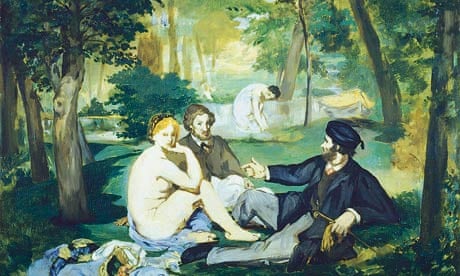
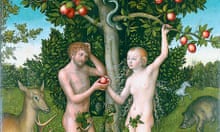

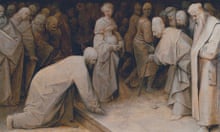
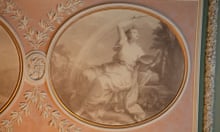
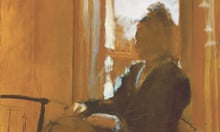
Comments (…)
Sign in or create your Guardian account to join the discussion